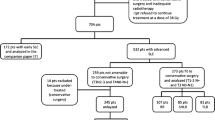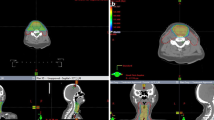Purpose:
To assess the patterns of failure in the treatment of early-stage squamous cell carcinoma of the glottic larynx.
Patients and Methods:
Between 1983–2000, 122 consecutive patients treated for early laryngeal cancer (UICC T1N0 and T2N0) by radical radiation therapy (RT) were retrospectively studied. Male-to-female ratio was 106 : 16, and median age 62 years (35–92 years). There were 68 patients with T1a, 18 with T1b, and 36 with T2 tumors. Diagnosis was made by biopsy in 104 patients, and by laser vaporization or stripping in 18. Treatment planning consisted of three-dimensional (3-D) conformal RT in 49 (40%) patients including nine patients irradiated using arytenoid protection. A median dose of 70 Gy (60–74 Gy) was given (2 Gy/fraction) over a median period of 46 days (21–79 days). Median follow-up period was 85 months.
Results:
The 5-year overall, cancer-specific, and disease-free survival amounted to 80%, 94%, and 70%, respectively. 5-year local control was 83%. Median time to local recurrence in 19 patients was 13 months (5–58 months). Salvage treatment consisted of surgery in 17 patients (one patient refused salvage and one was inoperable; total laryngectomy in eleven, and partial laryngectomy or cordectomy in six patients). Six patients died because of laryngeal cancer. Univariate analyses revealed that prognostic factors negatively influencing local control were anterior commissure extension, arytenoid protection, and total RT dose < 66 Gy. Among the factors analyzed, multivariate analysis (Cox model) demonstrated that anterior commissure extension, arytenoid protection, and male gender were the worst independent prognostic factors in terms of local control.
Conclusion:
For early-stage laryngeal cancer, outcome after RT is excellent. In case of anterior commissure extension, surgery or higher RT doses are warranted. Because of a high relapse risk, arytenoid protection should not be attempted.
Ziel:
Ergründung der Versagensmechanismen bei der Therapie des Larynxkarzinoms im Frühstadium.
Patienten und Methodik:
Zwischen 1983 und 2000 wurden 122 konsekutive Patienten, die wegen eines Larynxkarzinoms (UICC T1N0 und T2N0) eine Strahlentherapie erhielten, retrospektiv untersucht. Das Verhältnis von Frauen zu Männern betrug 106 : 16, das mittlere Alter lag bei 62 Jahren. Es handelte sich um 68 Patienten mit T1a-, 18 mit T1b- und 36 mit T2-Tumoren. Die Diagnose wurde bei 104 Patienten mit Hilfe einer Biopsie und bei 18 Patienten mit Laservaporisation oder Stripping gestellt. Bei 49 Patienten (40%) bestand die Behandlungsplanung aus einer dreidimensionalen konformalen Strahlentherapie, einschließlich neun Patienten, die unter Arytänoidprotektion bestrahlt wurden. Die mittlere Dosis von 70 Gy (60–74 GT) wurde über einen mittleren Zeitraum von 46 Tagen verabreicht. Die mittlere Nachbehandlungszeit erstreckte sich über 85 Monate.
Ergebnisse:
Das 5-Jahres-Überleben betrug 80%. Das tumorspezifische 5-Jahres-Überleben lag bei 94%, und 70% der Patienten blieben während dieses Zeitraums erkrankungsfrei. 83% wiesen nach 5 Jahren kein Lokalrezidiv auf. Der mittlere Zeitraum bis zum Auftreten eines lokalen Rückfalls belief sich bei 19 Patienten auf 13 Monate (5–58 Monate). Die Rezidivbehandlung bestand bei 17 Patienten aus einem chirurgischen Eingriff (ein Patient lehnte die Rezidivbehandlung ab, ein anderer war inoperabel; totale Laryngektomie bei elf und partielle Laryngektomie bzw. Kordektomie bei sechs Patienten). Sechs Patienten starben an ihrem Larynxkarzinom. Eine einseitige Varianzanalyse zeigte, dass die Ausbreitung auf die vordere Kommissur, die Arytänoidprotektion oder eine Strahlendosis < 66 Gy die Prognose der Lokalrezidive verschlechterte. Eine Multivarianzanalyse (Cox-Modell) belegte, dass unter den berücksichtigten Faktoren die Ausbreitung auf die vordere Kommissur, die Protektion des Aryknorpels und männliches Geschlecht die schlechtesten unabhängigen Prognosefaktoren im Hinblick auf Lokalrezidive sind.
Schlussfolgerung:
Beim Larynxkarzinom im Frühstadium erbringt die Strahlentherapie hervorragende Ergebnisse. Im Fall einer Ausbreitung auf die vordere Kommissur ist ein chirurgischer Eingriff oder eine höhere Strahlendosis erforderlich. Wegen des hohen Rezidivrisikos sollte keine Protektion des Aryknorpels vorgenommen werden.
Similar content being viewed by others
Author information
Authors and Affiliations
Corresponding author
Additional information
*Presented at the Sixth Annual Meeting of the Scientific Association of Swiss Radiation Oncology (SASRO), Zurich, March 14–16, 2002.
Rights and permissions
About this article
Cite this article
Zouhair, A., Azria, D., Coucke, P. et al. Decreased Local Control Following Radiation Therapy Alone in Early-Stage Glottic Carcinoma with Anterior Commissure Extension*. Strahlenther Onkol 180, 84–90 (2004). https://doi.org/10.1007/s00066-004-1164-y
Received:
Accepted:
Issue Date:
DOI: https://doi.org/10.1007/s00066-004-1164-y




